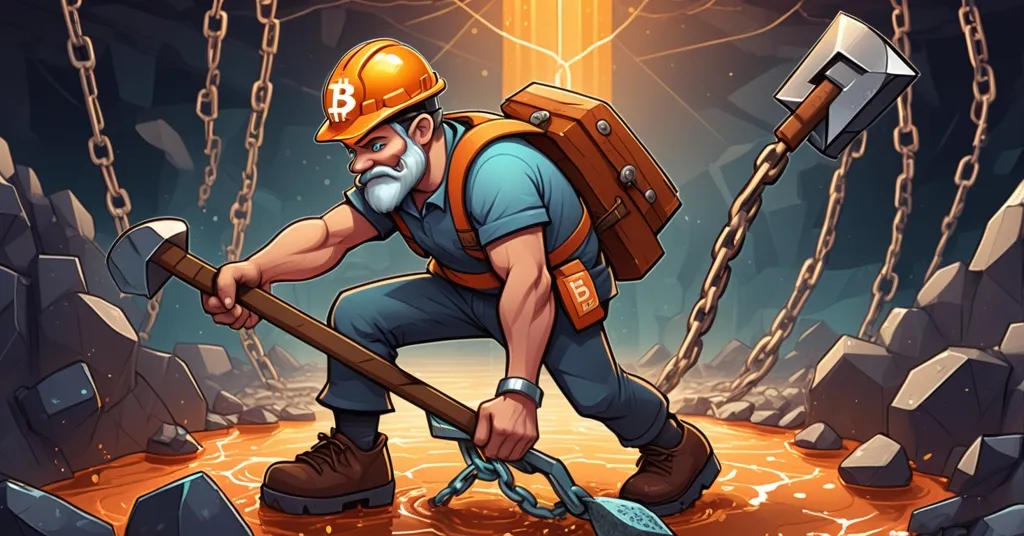DMND Launches First Stratum V2 Bitcoin Mining Pool: Boosting Decentralization

DMND Launches First Bitcoin Mining Pool Using Stratum V2: A Leap Towards Decentralization
DMND has launched the world’s first Bitcoin mining pool based on the Stratum V2 protocol, marking a significant step towards enhancing security and decentralization in Bitcoin mining. This move empowers miners with more control over transaction selection, challenging the dominance of centralized pools and aligning with Bitcoin’s core principles.
- DMND introduces Stratum V2: More control for miners
- Empowering transaction selection
- Challenging centralized pools
In a bold move to enhance the security and decentralization of Bitcoin mining, DMND has launched the world’s first mining pool based on the innovative Stratum V2 protocol. This development could be a game-changer, allowing miners to take back control from centralized pools and align with Bitcoin’s core ethos.
What is Stratum V2?
Stratum V2, a new mining protocol designed to enhance security and decentralization, shifts the power dynamics in Bitcoin mining by allowing individual miners to choose which transactions they include in blocks. This is a significant departure from the traditional Stratum V1, where pool operators held considerable sway over transaction selection. By implementing Stratum V2, DMND is not just offering a new tool; it’s championing a return to Bitcoin’s core principles of decentralization and miner autonomy.
Bitcoin mining involves solving complex mathematical puzzles to validate transactions and add them to the blockchain. Decentralization in this context means spreading out the power to control transaction validation among many participants, rather than a few dominant pools.
Benefits of Stratum V2
DMND’s CEO, Alejandro de la Torre, passionately stated:
Stratum V2 allows miners to have greater control over their mining operations by enabling them to select transactions for inclusion in blocks.
This shift could dramatically reduce the influence of large mining pools, which have long been criticized for centralizing power within the Bitcoin network. Say goodbye to those sneaky pool operators who think they’re the bosses of Bitcoin!
Moreover, DMND’s innovative SLICE payment system, which combines Pay Per Last N Share (PPLNS) with Stratum V2’s Job Declaration, promises to maximize miner payouts while eliminating hidden fees. This could be a boon for miners who have long felt squeezed by the opaque fee structures of traditional pools.
Stratum V2 also introduces enhanced security features, such as end-to-end encryption to prevent hashrate hijacking, a vulnerability that plagued Stratum V1. This added layer of security is crucial in maintaining the integrity of the Bitcoin network.
Challenges Ahead
However, the path to widespread adoption of Stratum V2 is not without its hurdles. Resistance from established mining pools, technical challenges in implementation, and the need to educate miners about the protocol’s benefits are all potential obstacles. Yet, DMND is already taking steps to overcome these challenges, having opened applications for miners to join as launch partners.
Critics might argue that Stratum V2 is just another flash in the pan, but DMND’s move is part of a broader movement within the Bitcoin community to address the growing concerns about mining centralization. Other initiatives, such as OCEAN’s DATUM, are also pushing for greater decentralization. This collective effort signals a significant shift towards a more equitable and resilient Bitcoin network.
Future Implications
As we look to the future, the impact of Stratum V2 on Bitcoin’s network could be profound. By empowering miners and reducing the influence of centralized pools, it has the potential to foster a more resilient and decentralized ecosystem. However, the success of this endeavor will depend on the willingness of the mining community to embrace this new protocol and the ability of pioneers like DMND to navigate the challenges ahead.
Is DMND’s move a game-changer, or just another flash in the pan? Only time will tell, but one thing is clear: the era of miner empowerment has begun.
Key Takeaways and Questions:
- What is Stratum V2 and how does it work?
Stratum V2 is a new mining protocol designed to enhance security and decentralization in Bitcoin mining. It works by allowing miners to select transactions for inclusion in blocks, thereby reducing the influence of pool operators.
- How does Stratum V2 address the issue of centralization in Bitcoin mining?
By empowering individual miners to choose transactions, Stratum V2 reduces the control of pool operators, promoting a more decentralized mining ecosystem.
- What are the potential benefits of DMND’s implementation of Stratum V2?
The potential benefits include increased security, greater decentralization, a more equitable distribution of mining power, and a more resilient Bitcoin network.
- What challenges might DMND face in promoting the adoption of Stratum V2?
Challenges could include resistance from existing mining pools, technical difficulties in implementation, and the need to educate miners about the benefits of the new protocol.
DMND’s launch of the first Stratum V2 pool is a bold step towards a more decentralized and secure Bitcoin network. While the road ahead may be challenging, the potential rewards for the entire Bitcoin ecosystem are immense. The era of miner empowerment has begun, and as the industry watches and waits, the future of Bitcoin mining looks increasingly decentralized.



